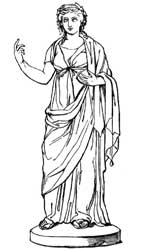Ariadne

A daughter of Minos and Pasiphaë or Creta.1 When Theseus was sent by his father to convey the tribute of the Athenians to the Minotaur, Ariadne fell in love with him, and gave him the string by means of which he found his way out of the Labyrinth, and which she herself had received from Hephaestus. Theseus in return promised to marry her,2 and she accordingly left Crete with him; but when they arrived in the island of Dia (Naxos), she was killed there by Artemis.3
The words added in the Odyssey, Διονύσου μαρτυρίῃσιν (Dionysou martyriēsin), are difficult to understand, unless we interpret them with Pherecydes by "on the denunciation of Dionysus," because he was indignant at the profanation of his grotto by the love of Theseus and Ariadne. In this case Ariadne was probably killed by Artemis at the moment she gave birth to her twin children, for she is said to have had two sons by Theseus, Oenopion and Staphylus. The more common tradition, however, was, that Theseus left Ariadne in Naxos alive; but here the statements again differ, for some relate that he was forced by Dionysus to leave her,4 and that in his grief he forgot to take down the black sail, which occasioned the death of his father.
According to others, Theseus faithlessly forsook her in the island, and different motives are given for this act of faithlessness.5 According to this tradition, Ariadne put an end to her own life in despair, or was saved by Dionysus, who in amazement at her beauty made her his wife, raised her among the immortals, and placed the crown which he gave her at his marriage with her, among the stars.6 The Scholiast on Apollonius Rhodius7 makes Ariadne become by Dionysus the mother of Oenopion, Thoas, Staphylus, Latromis, Euanthes, and Tauropolus.
There are several circumstances in the story of Ariadne which offered the happiest subjects for works of art, and some of the finest ancient works, on gems as well as paintings, are still extant, of which Ariadne is the subject.
❧
Richard Strauss composed a musical drama called Ariadne auf Naxos.
Iconography
The famous François vase (ca. 570 BCE) at Florance depicts how Theseus abandons Ariadne at Naxos. The same scene is depicted on a mural at the Casa del Poeta Tragico at Pompeii. The Villa dei Misteri, also at Pompeii, shows Ariadne with Dionysus on the frieze in the "sala dell' grande affresco." The "sleeping Ariadne" is a famous sculpture from the first century BCE, housed in the Vatican since the sixteenth century. The German sculptor Dannecher created a sculpture of Ariadne riding a panther (the panther is the animal sacred to Dionysus).
References
Notes
- Pseudo-Apollodorus. The Library iii, 1.2.
- Plutarch. Theseus, 19; Hyginus. Fabulae, 42; Didymos on Homer's Odyssey xii, 320.
- Homer. Odyssey xii, 324.
- Diodorus Siculus, iv, 61; v, 51; Pausanias. Description of Greece i, 20.2; ix, 40.2; x, 29.2.
- Plutarch. Theseus, 20; Ovid. Metamorphoses viii, 175; Heroides, 10; Hyginus. Fabulae, 43.
- Hesiod. Theogony, 949; Ovid, l.c.; Hyginus. Poetical Astronomy ii, 5.
- iii, 996.
Sources
- Aken, Dr. A.R.A. van. (1961). Elseviers Mythologische Encyclopedie. Amsterdam: Elsevier.
- Smith, William. (1870). Dictionary of Greek and Roman Biography and Mythology. London: Taylor, Walton, and Maberly.
This article incorporates text from Dictionary of Greek and Roman Biography and Mythology (1870) by William Smith, which is in the public domain.